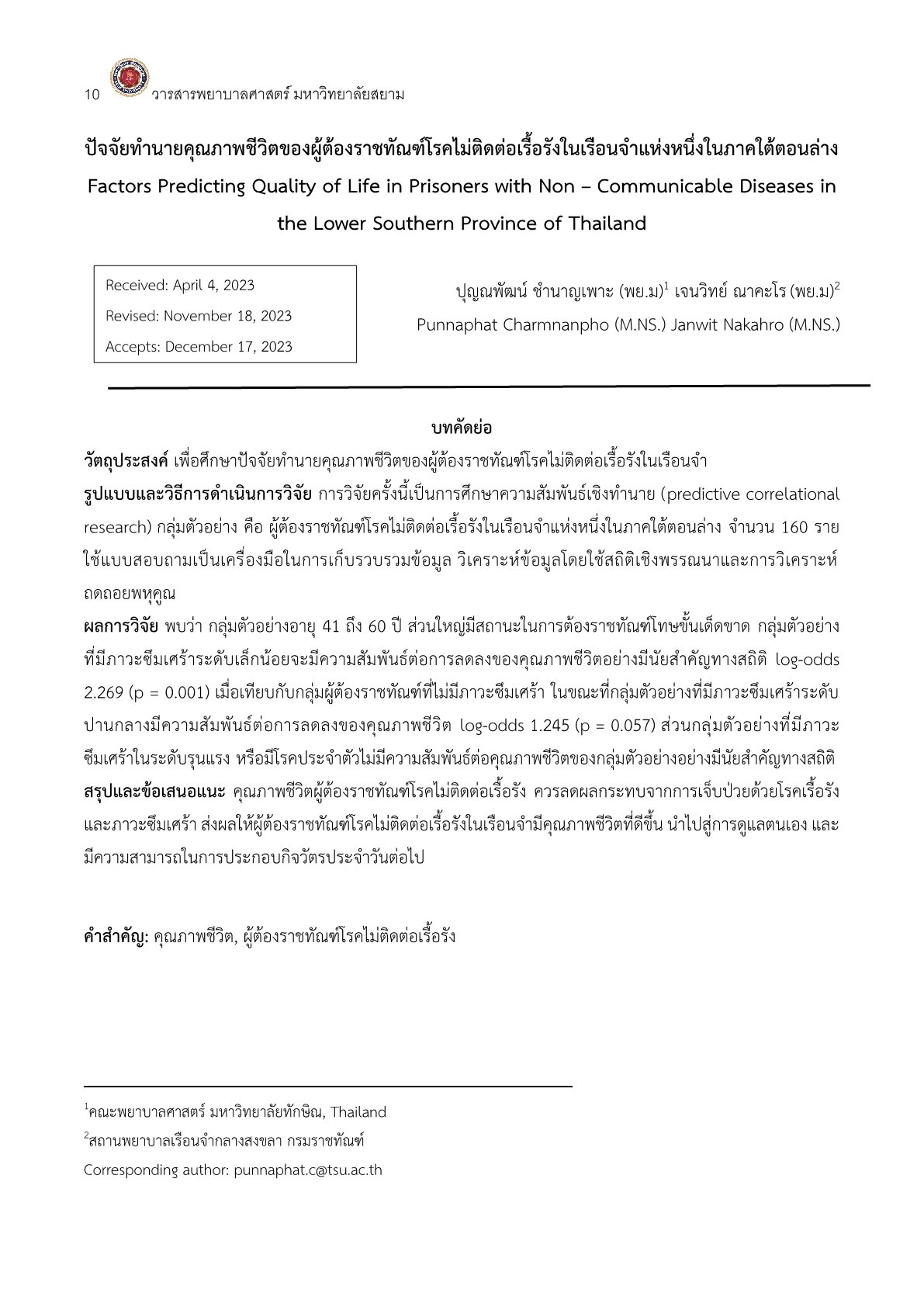Factors Predicting Quality of Life in Prisoners with Non – Communicable Diseases in the Lower Southern Province of Thailand
Keywords:
quality of life, non-communicable diseases prisonersAbstract
Objectives: This study aimed to examine the factors predicting prisoners’ quality of life with non-communicable diseases (NCDs).
Methods: This research employed a predictive correlational design and included a sample group of 160 prisoners with NCDs in the lower southern province of Thailand. Data were collected using a questionnaire and analyzed using descriptive statistics and multiple regression analysis.
Results: The research results indicate that, in the sample group aged 41 to 60, individuals experiencing mild depression have a statistically significant correlation with a significant decrease in quality of life, with a log-odds of 2.269 (p = 0.001) when compared to the group of non-depressed individuals among those subject to compulsory military service. Meanwhile, the sample group with moderate depression shows a correlation with a decrease in quality of life, with a log-odds of 1.245 (p = 0.057). On the other hand, the sample group with severe depression or chronic diseases does not exhibit a statistically significant correlation with the quality of life.
Conclusion and recommendations: To enhance the quality of life for prisoners with NCDs, it is important to address the impact of chronic illness and depression. By doing so, prisoners with NCDs can experience an improved quality of life, increased self-care, and better ability to carry out daily activities.
References
จันจิรา หินขวา, ยศพล เหลืองโสมนภา, นวนันท์ ปัทมสุทธิกุล, จีราภา ศรีท่าไฮ, สุกัญญา ขันวิเศษ และปิยวดี พุฒไทย. (2560). คุณภาพชีวิตของผู้ป่วยโรคเรื้อรังในเขตพื้นที่รับผิดชอบขององค์การบริหารส่วนตำบลท่าช้าง จังหวักจันทบุรี. วารสารวิจัยทางวิทยาศาสตร์สุขภาพ. 11(1); 23-32.
ผกามาศ เพชรพงศ์. (2562). ภาวะซึมเศร้าในผู้สูงอายุที่ป่วยด้วยโรคเบาหวานในอำเภอวชิรบารมี จังหวัดพิจิตร. วารสารโรคและภัยสุขภาพ สำนักงานป้องกันควบคุมโรคที่ 3 จังหวัดนครสวรรค์. 13(2); 25-32.
ปัฐยาวัชร ปรากฏผล, อุทัยทิพย์ จันทร์เพ็ญ และกนกพร แก้วโยธา. (2564). ปัจจัยที่มีความสัมพันธ์กับการจัดการตนเองและคุณภาพชีวิตของผู้ป่วยโรคเรื้อรังที่อาศัยอยู่ในเขตเทศบาลเมือง. วารสารสุขภาพและการศึกษาพยาบาล. 27(1); 151-165.
ปิยธิดา ชุมสงค์ และอารีวรรณ เชี่ยวชาญวัฒนา. (2562). คุณภาพชีวิตด้านสุขภาพของผู้ป่วยโรคเรื้อรังในโรงพยาบาลชุมชน: กรณีศึกษาโรงพยาบาลบ้านไผ่จังหวัดขอนแก่น. วารสารเภสัชกรรมไทย. 12(4); 1051-1064.
สุวัฒน์ มหัตนิรันดร์กุลม, วิระวรรณ ตันติพิวัฒนสกุล และวนิดา พุ่มไพศาลชัย. (2545). เครื่องชี้วัดคุณภาพชีวิตขององค์การอนามัยโลกชุดย่อ ฉบับภาษาไทย. โรงพยาบาลสวนปรุง จังหวัดเชียงใหม่
อรรถเกียรติ กาญจนพิบูลวงศ์, ภาณุวัฒน์ คำวังสง่า และสุธิดา แก้วทา. (2563). รายงานสถานการณ์โรค NCDs เบาหวาน ความดันโลหิตสูง และปัจจัยเสี่ยงที่เกี่ยวข้อง พ.ศ. 2562. กลุ่มเทคโนโลยีระบาดวิทยา และมาตรการชุมชน กองโรคไม่ติดต่อ กรมควบคุมโรค กระทรวงสาธารณสุข.
อรัญญา นามวงศ์, เอกพันธ์ คําภีระ, คอย ละอองอ่อน และวัชรี ไชยจันดี. (2561). ปัจจัยคัดสรรที่สัมพันธ์กับภาวะซึมเศร้าของผู้สูงอายุโรคเรื้อรังในชุมชน. วารสารการพยาบาลการสาธารณสุขและการศึกษา. 19(2); 94-105.
Bellali T., Manomenidis G., Karamitri I., Malliarou M., Igoumenou A., and Bellali N. (2020). Health-related quality of life of prisoners with diabetes mellitus. Journal of Forensic and Legal Medicine;73.101971.
Hammen C. (2005). Stress and depression. Annu. Rev. Clin. Psychol. ;1.293-319.
King, C. & Hinds. P. (1998). Quality of Life: From Nursing and Patients Perspectives. Boston: Jones and Bartlett Publishers.
Skowroński B. and Talik E. (2021). Quality of life correlates with people serving prison sentences in penitentiary institutions. International Journal of Environmental Research and Public Health;18(4), 1655.
The WHOQOL Group. (1996). WHOQOL-BREF introduction, administration, scoring and generic version of assessment, field trail version. Geneva: WHO.
World Health Organization. (2022).Noncommunicable diseases: progress monitor 2022. [Internet]. Switzerland: WHO; 2020 [cited2022Jan2]. Availablefrom:https://www.who.int/newsroom/fact-sheets/detail/non-communicable diseases.
Wright M. Hearty P. and Allgar V. (2019). Prison primary care and non-communicable diseases: a data-linkage survey of prevalence and associated risk factors. BJGP Open;3(2).
Yamane T. (1967). Statistics. An Introductory Analysis. 2nd Ed. New York: Harper and Row.

Downloads
Published
How to Cite
Issue
Section
License
Copyright (c) 2023 Journal of Nursing, Siam University

This work is licensed under a Creative Commons Attribution-NonCommercial-NoDerivatives 4.0 International License.
Content and information published in the Journal of Nursing, Siam University is the comment and responsibility of the authors.
Articles, information, images, etc. published in the Journal of Nursing. Siam University is the copyright of the Journal of Nursing, Siam University. If any person or entity wants to take all or part of it for publication for any purposes, please reference the Journal of Nursing, Siam University.


